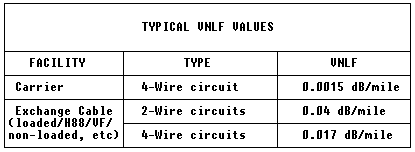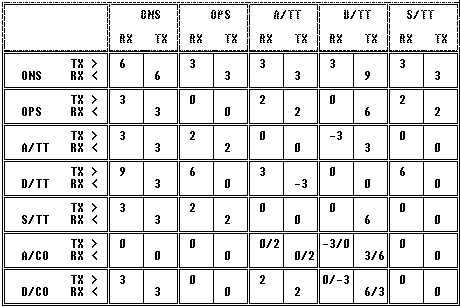| RETURN | Voice Networking |
Loss Planning
Ideally, a loss plan should provide a value of loss that is close to optimal for all connection lengths. At the same time, the plan needs to be flexible and easy to implement.
There are basically two types of Loss Plans; Fixed Loss, and Via Net Loss (VNL) Plans.
Analog systems and switches can take advantage of both types of Loss Plans. However, Digital systems are only implemented with Fixed Loss Plans.
IF THE LOSS IS NOT KNOWN, DESPITE AN EFFORT TO OBTAIN THIS INFORMATION IN ADVANCE, IT IS SUGGESTED THAT A FIXED AMOUNT OF LOSS BE INSERTED ON ANALOG TRUNK CIRCUITS.
The following subsections detail standardized Analog and Digital plans.
Analog System Loss Plans
This section details Loss Plans that can be implemented with customers that operate in an all-analog environment. This means that both the switch, and interconnecting transmission facilities are analog.
There are basically two types of available loss plans that can be implemented; Via Net Loss and Fixed Loss.
U.S. PSTN and Private Network Via Net Loss (VNL)
The VNL plan was originally developed in the 1950s and based upon an analog network. The VNL Loss Plan is described in the following subsections.
The VNL loss plan is described in ATT Pub 43201 and in ‘Notes On The BOC IntraLATA Networks, 1986’.
VNL as a Function of Path Delay
The VNL loss plan can be expressed in the following formula:
Loss = 4.0 + (0.1 * D) + 0.4
D = Echo path delay (mS)
--------------------------------------------------------------------------
The equation is then simplified as: Loss = 4.0 + VNL,
where VNL = (0.1 * D) + 0.4.
--------------------------------------------------------------------------
VNL as a Function of Circuit Length
To keep things simple, without having to calculate Echo Path Delay, the VNL values were then expressed as: VNL = (VNLF * d) + 0.4, where VNLF is the Via Net Loss Factor, and d is the 1-way circuit distance. The VNLF is based upon the loss in dB per mS of round-trip delay and the velocity of propagation THROUGH VOICE OR OTHERWISE ANALOG CARRIER FACILITIES.

Later, a ‘stepped’ VNL formula was implemented within the PSTN for administrative reasons, with each “step” a representing a distance range. The first step was to be 0.5 dB and each subsequent step assigned a value of 0.3 dB. The following table is derived:
------------------------------
| CIRCUIT MILES | VNL = ICL |
------------------------------|
| 0 - 165 | 0.5 |
| 166 - 365 | 0.8 |
| 366 - 565 | 1.1 |
| 566 - 765 | 1.4 |
| 766 - 965 | 1.7 |
| 966 - 1165 | 2.0 |
| 1166 - 1365 | 2.3 |
| 1366 - 1565 | 2.6 |
| 1566 - 1850 | 2.9 |
| Echo supp./ | |
| canclr req. | |
-------------------------------
Analog VNL Loss Implementation & Allocation
When implementing the loss, the Originating switch should insert 2 dB of loss into both the transmit and receive sides of the trunk connection. The Terminating switch should insert 2 dB of loss into both transmit and receive sides of the connection. At this point, there is 4 dB of end-to-end loss. The additional loss, the VNL factor, is inserted into the circuit as Inserted Circuit Loss (ICL) by the trunks, in each direction.


CCITT G.171 (‘Transmission Plan Aspects of Privately Owned Networks’) calls for a Loss Plan similar to the ‘Stepped’ VNL Plan. Where the ‘Stepped’ loss plan called for an intial VNL (ICL) loss of 0.5 dB followed by steps of 0.3 dB, the CCITT plan calls for a fixed amount of loss (0.5) dB, implemented on each trunk circuit. The 2 dB pads in the PBX are switched in at the Originating and Terminating switch, and out on the Tandem switch. This is illustrated below:

In the United States, there are no specifications regarding Fixed Loss plan implementation in an analog environment. In a mixed digital/analog environment, standard VNL loss allocation is applied to analog trunks, and Fixed Loss applied to digital trunks. However, it has been observed that many U.S. customers have implemented analog fixed loss plans, presumably for simplicity.
Fixed Loss plans can be used with some success in smaller networks, where geographical locations are fairly close. In this environment, the loss inserted into the small circuit lengths under the VNL plan may be greater than what is actually required.
However, CCITT does offer a Fixed Loss plan alternative in CCITT G.171. Under this plan, 3.5 dB pads are switched into both the transmit and receive legs of the Originating PBX trunk. Tandem PBXs will switch out these 3.5 dB pads, and the Terminating PBX will switch in 3.5 dB pads into both directions. The communications facilities do not insert any loss. Refer to the following diagram:

When analog or multiplexer facilities are installed into a voice network operating with a Fixed Loss plan, the modules should be adjusted to the TLP values, without inserting any additional loss.
WHILE T1 TRANSMISSION DELAYS ARE LOWER THAN CABLE DELAYS ANY MULTIPLEXER OR OTHER DIGITAL PROCESSING EQUIPMENT WILL LIKELY ADD MORE DELAY TO THE CIRCUIT. THEREFORE, PRIOR TO INSTALLATION OF DIGITIAL MULTIPLEX EQUIPMENT, ITS A GOOD IDEA TO IDENTIFY WHAT TYPE OF LOSS PLAN IS IMPLEMENTED. THEN, SELECT A LOSS VALUE THAT IS GREATER THAN OR EQUAL THE VNL LOSS VALUES:
Fixed Loss ò 4.0 + VNL
D = Echo path delay (mS)
VNL = (0.1 * D) + 0.4.
Digital System Loss Plans
This section details Loss Plans that can be implemented with customers that operate in a digital environment.
There are basically two types of available loss plans that can be implemented; the CCITT G.171 Loss Plan for Digital Private Networks, and the EIA Loss Plan developed by ANSI. Note that the EIA Loss Plan is also included in CCITT G.171 because of its ability to support mixed analog and digital networks.
Both of these plans are based upon a fixed amount of loss inserted in the Originating and Terminating PBXs. Fixed Loss plans are ideal for the digital environment since they do not require that PCM channel attenuation be provided on each individual trunk. However, both CCITT and EIA plans recommend that VNL planning (e.g. Variable Loss) be additionally installed on analog trunks.
Both plans are discussed in the following sections.
CCITT G.171 Digital Network Plan
This loss plan is patterned after the PRE-DIVESTITURE ATT Switched Digital Network (SDN).
Under this Fixed Loss plan, the Local Switch-to-Local Switch loss is 6 dB for most connections. The end-to-end station loss is 12 dB for connections terminating into On-premises Stations (ONS) at each end. Refer to the following diagram:


The EIA Digital Loss plan is described in CCITT G.171, and EIA TSB-32. This is similar to the CCITT plan in that there is 6 dB Local Switch-to-Local Switch loss, and 12 dB ONS to remote ONS loss.
However, the allocation of loss is different. The following matrix depicts the PBX losses, depending upon the connection type. Note that digital facilities (e.g. ILP) do not insert any additional loss. In most cases, tandem PBXs will not insert any loss, with a few exceptions.

Abbreviations used:
-------------------
ONS = On-premise Station
OPS = Off-premise Station
A/TT = Analog TIE trunk
D/TT = Digital TIE trunk
S/TT = Satellite TIE trunk (either analog or digital)
A/CO = Analog Central Office trunk
D/CO = Digital Central Office trunk
Based upon the matrix listed above, some typical loss diagrams are depicted in the following diagrams.
Tie Trunk Diagrams
ONS – Hybrid Digital/Analog Trunks
PBX – CO Trunks
OPS – PBX Lines